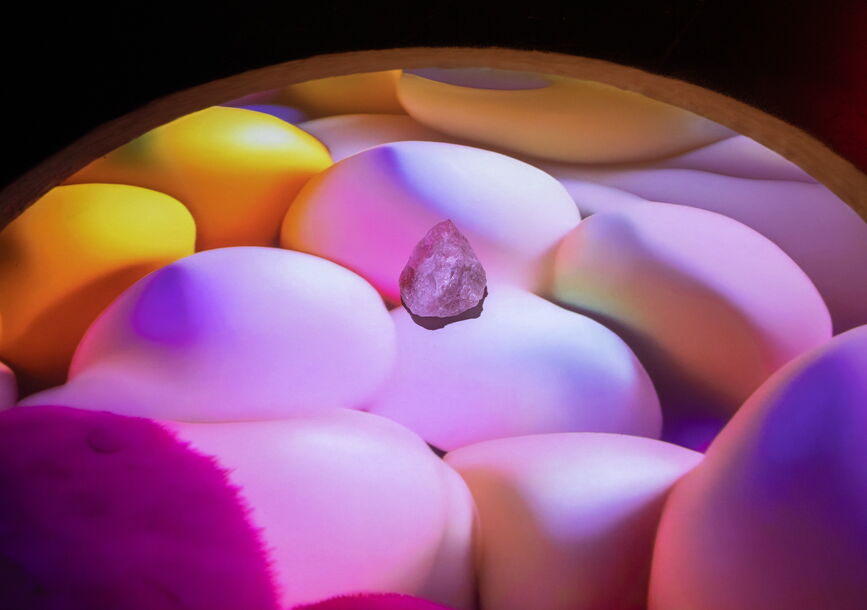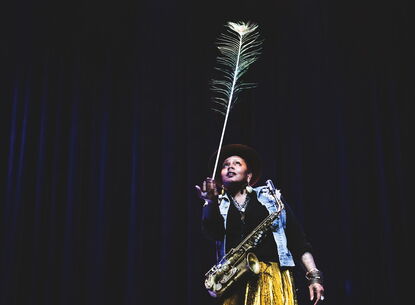
Nora Al-Badri, Minne Atairu, Stephanie Dinkins, Mashinka Firunts Hakopian with Dahlia Elsayed and Andrew Demirjian, Interspecifics, Kite, Charmaine Poh, Sarah Rosalena, Kira Xonorika
About the Artists
Nora Al-Badri
Nora Al-Badri is a multi-disciplinary and conceptual media artist with a German-Iraqi background. Her works are research-based as well, paradisciplinary, and post-colonial. She graduated in political sciences at Johann Wolfgang Goethe University in Frankfurt/Main and is a lecturer at the Eidgenössische Hochschule (ETH) in Zurich and a guest professor at the Academy of Arts in Stuttgart. Her practice focuses on the politics and the emancipatory potential of new technologies such as machine intelligence or data sculpting. Al-Badri’s artistic material is a speculative archaeology from fossils to artefacts or performative interventions in museums and other public spaces, that respond to the inherent power structures. She has exhibited in the Viktoria and Albert Museums’ Applied Arts Pavilion at La Biennale di Venezia, Design Biennal Istanbul, ZKM Karlsruhe, KW Contemporary Berlin, Science Gallery Dublin, NRW Forum, European Media Art Festival, Transmediale, Space Fundacion Telefonica, Ars Electronica amongst others. Her work has been featured on international media such as The New York Times, BBC, The Times, Artnet, Wired, Le Monde Afrique, Financial Times, Arte TV, The Independent, New Statesmen, Hyperallergic, Smithsonian, Al Ahram, Vice, Hürriyet, Dezeen, Frankfurter Allgemeine Sonntagszeitung, Spiegel Online, Heise, The Boston Globe, Archdaily, Polska, La informacion, De Volkskrant, Gizmodo, New Scientist, Popular Science and The Verge amongst others. Al-Badri lives and works in Berlin.
Minne Atairu
Minne Atairu is a researcher and interdisciplinary artist interested in generative artificial intelligence. Utilizing AI-mediated processes, and materials, Atairu’s artistic practice is dedicated to illuminating understudied gaps and absences within Black historical archives. Atairu’s academic research focuses on Generative AI, Art and Educational policy in urban K-12 Art classrooms. Minne has exhibited at The Shed, New York (2023), Frieze, London (2023), The Harvard Art Museums, Boston (2022); Markk Museum, Hamburg (2021); SOAS Brunei Gallery University of London, London (2022); Microscope Gallery, New York (2022) and Fleming Museum of Art, Vermont (2021). Atairu is the recipient of the 2021 Lumen Prize for Art and Technology (Global Majority Award) and The Graham Foundation Grant for Research (2023).
Stephanie Dinkins
Stephanie Dinkins is a transdisciplinary artist and educator whose work intersects emerging technologies and our future histories. Her art practice is deeply committed to creating platforms for dialogue about AI as it intersects with these critical societal issues. As an LG - Guggenheim Awardee and one of Time Magazine’s 100 Most Influential People in AI, Dinkins leverages technology and storytelling to challenge and reimagine the narratives surrounding marginalized communities, particularly those of Black and brown individuals. Through her installations, digital platforms, and community-based projects, Dinkins seeks not only to question the current paradigms of AI development but also to forge paths toward more equitable and inclusive technological futures. Her work emphasizes the importance of incorporating diverse voices and perspectives into the design and application of AI, advocating for a future where technology uplifts and amplifies underrepresented histories and experiences and fostering a tech ecosystem that is truly beneficial for all. She exhibits internationally and publicly advocates for inclusive AI internationally at a broad spectrum of community, private, and institutional venues.
Dahlia Elsayed and Andrew Demirjian
Dahlia Elsayed and Andrew Demirjian use contemporary and historical research to create tactile objects and visual experiences that pull from the past to anticipate alternative futures. They are known for bright and thought provoking immersive mixed media installations which are influenced by their South West Asian and North African backgrounds.Their collaborative work has been exhibited widely in the US and internationally, including: Locust Projects, Miami, FL, The Ford Foundation Gallery, New York, NY, The Arab American National Museum, Dearborn, MI, Transformer Gallery, Washington, DC, The Visual Art Center of New Jersey, Summit, NJ, Laznia Center for Contemporary Art, Gdansk, Poland, and the Siren Arts Festival, Asbury Park, NJ. Their work has been supported and recognized by The New Jersey State Council on the Arts, The Visual Studies Workshop, CEC Artslink, the Grand Canyon National Park Residency, Sculpture Magazine, and Hyperallergic amongst others. Dahlia Elsayed is a Professor of Humanities & Art at CUNY LaGuardia Community College, Long Island City, NY. Andrew Demirjian is Associate Professor of Film & Media Studies at CUNY Hunter College, New York, NY.
Mashinka Firunts Hakopian
Mashinka Firunts Hakopian is an Armenian writer, artist, and researcher born in Yerevan and residing in Glendale, CA. She is an Associate Professor in Technology and Social Justice at ArtCenter College of Design. She is the author of The Institute for Other Intelligences (X Artists’ Books, 2022). With Meldia Yesayan, she is the co-curator of “What Models Make Worlds: Critical Imaginaries of AI” at Ford Foundation Gallery in 2023 and “Encoding Futures” at OXY ARTS in 2021. Her performances and projects have been presented at the Centre Pompidou, the New Museum, 2220 Arts + Archives, the Institute for Contemporary Art in Philadelphia, and elsewhere. She is a contributing editor at ART PAPERS, where she guest edited the spring 2023 special issue on AI with Sarah Higgins. She is a 2024 Eyebeam Democracy Machine Fellow.
Interspecifics
Interspecifics is an international independent artistic research studio established in Mexico City in 2013. Their research has focused on utilizing sound and artificial intelligence to investigate the emergence of patterns—ranging from biosignals and the morphology of various living organisms—potentially offering a form of nonhuman communication. With this aim in mind, they’ve curated a collection of experimental research and educational tools called Ontological Machines. Their work is deeply influenced by the Latin American context, where the conditions of precarity foster creative endeavors and traditional technologies intersect with cutting-edge production methods. Their current lines of research are shifting towards exploring ‘The hard problem of consciousness’ and the close relationship between mind and matter, where magic appears to be fundamental. Sound remains their interface to the universe.
Kite
Kite (Dr. Suzanne Kite) (Music, BFA ‘14) is an Oglála Lakȟóta performance artist, visual artist, and composer raised in Southern California, with a BFA from CalArts in music composition, and an MFA from Bard College’s Milton Avery Graduate School, and a Ph.D. in Fine Arts from Concordia University, Montreal. Kite’s scholarship and practice investigate contemporary Lakȟóta ontologies through research-creation, computational media, and performance, often working in collaboration with family and community members. Recently, Kite has been developing body interfaces for machine learning driven performance and sculptures generated by dreams, and experimental sound and video work. Kite has published in The Journal of Design and Science (MIT Press), with the award-winning article, “Making Kin with Machines,” co-authored with Jason Lewis, Noelani Arista, and Archer Pechawis. Kite is currently a 2023 Creative Capital Award Winner, 2023 USA Fellow, and a 2022-2023 Creative Time Open Call artist with Alisha B. Wormsley. Kite is currently a distinguished Artist in Residence and Assistant Professor of American and Indigenous Studies, Bard College and a Research Associate and Residency Coordinator for the Abundant Intelligences (Indigenous AI) project.
Charmaine Poh
Charmaine Poh (b. 1990) is an artist from Singapore working across media, moving image, and performance to peel apart, interrogate, and hold ideas of agency, repair, and the body across worlds. She aligns herself with strategies of visibility, opacity, deviance, and futurity.
Her practice initially focused on using experimental documentary photography to explore how femininity and queerness are articulated. In 2021, she embarked on THE YOUNG BODY UNIVERSE, a series of techno-feminist enactments drawing from her experience as a child actor in the 2000s. Her work centres the affects of vulnerability, desire, and intimacy from the vantage point of subversion. She has exhibited at the Singapore Art Museum, the Seoul Museum of Art, the Leslie Lohman Museum, and the 60th Venice Biennale - Foreigners Everywhere, among others. In 2019, she was one of Forbes Asia’s 30 under 30 in the arts. Based between Berlin and Singapore, she is a co-founder of the magazine Jom and a member of the collective Asian Feminist Studio for Art and Research (AFSAR).
Sarah Rosalena
Sarah Rosalena (Wixárika) is an interdisciplinary artist working between traditional craft techniques and emerging technology. She is Assistant Professor of Art in Computational Craft at UC Santa Barbara. She was recently awarded the Artadia Award, Creative Capital Award, the LACMA Art + Tech Lab Grant, the Steve Wilson Award from Leonardo, the International Society for Art, Sciences, and Technology, and the Carolyn Glasoe Bailey Art Prize. She has had solo exhibitions with the Columbus Museum of Art, LACMA Art + Tech Lab, the Museum of Contemporary Art Santa Barbara, Clockshop, and Blum & Poe Gallery. Her work is in the permanent collection at LACMA, the Columbus Museum of Art, and the Raclin Murphy Museum of Art.
Kira Xonorika
Kira Xonorika is an artist, writer, researcher and futurist whose work explores the connections between technoscience, sovereignty, worldbuilding, and magic. Her writing has been published in e-flux, Momus among others. Recent exhibitions include ”What Models Make Worlds: Critical Imaginaries of AI” at the Ford Foundation Gallery and ”Small V01ce” at Honor Fraser. In 2024 she will spearhead the first GenAI residency in South America, the ”Future Memory Lab.”
credits
Exhibition Curator: Daniela Lieja Quintanar
Performance Program Curators: Katy Dammers, Daniela Lieja Quintanar, and Edgar Miramontes
Assistant Curator: Talia Heiman
Technical Director: Adam Matthew
Exhibition Designer: Adalberto Charvel
Graphic Designer: Ella Gold
Publication: REDCAT/East of Borneo
Project Director: Joao Ribas











